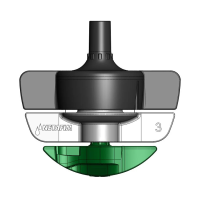10
UPSIDE-DOWN MICRO-EMITTERS HANDBOOK
MICRO-SPRINKLER/EMITTER SELECTION
There are 3 methods for calculating distribution uniformity:
• Christiansen Coefficient of Uniformity (%CU) - known to produce the most flattering results.
• Distribution uniformity (%DU) - known to be more rigorous than %CU.
• Scheduling Coefficient (SC) - known to be the most rigorous method of all.
Christiansen Coefficient of Uniformity (%CU)
The %CU is a measurement of uniformity, expressed as the average rate (%) of deviation from the overall
average application.
A perfectly uniform application is represented by a CU of 100%.
Lower uniformity applications are represented by lower percentages.
For micro-sprinkler/emitter irrigation of protected crops:
94% or higher Excellent uniformity
89% to 94% Very good uniformity
Lower than 89% Acceptable for certain low-value crops only
Limitation of the %CU method:
Due to the statistical nature calculation of the %CU method, it does not account for individual spots that
receive no water at all.
Calculating %CU
1.
Gather the water levels previously collected in each gauge or can (mm) [a].
2.
Sum all the numbers in column [a].
3.
The sum is divided by the number of gauges or cans placed. This provides the average net application of
the surveyed area [b].
4.
The average net application of the surveyed area [b] is subtracted from the amount of water collected
in each gauge or can (mm) [a]. Each result, whether lower or higher than the average net application, is
recorded as a positive number in column [c].
5.
All application deviations [c] are summed up.
6.
The sum is divided by the number of gauges/cans placed. This provides the average deviation from the
average net application of the surveyed area [d].
7.
The average deviation from the average net application [d] is divided by the average net application of
the surveyed area [b] and the result are subtracted from 1. This provides the CU of the surveyed area as
a percentage (%) [e].
NOTE
For simplicity, the examples below are based on 20 gauges/cans placed.

